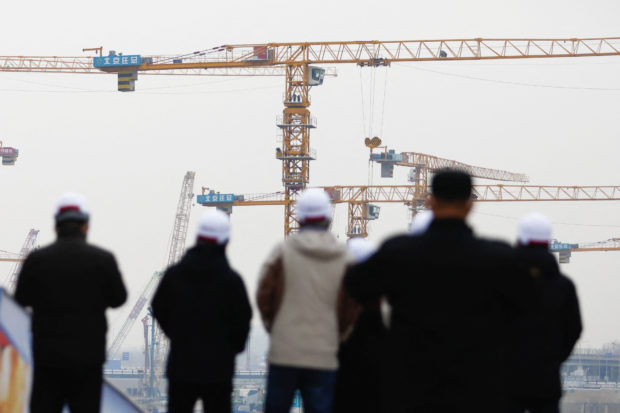
People look on near cranes standing at a construction site in Beijing, China January 12, 2023. REUTERS/Tingshu Wang/File photo
BEIJING – China’s economy slowed sharply in the fourth quarter due to stringent COVID curbs, dragging down 2022 growth to one of its worst in nearly half a century and raising pressure on policymakers to unveil more stimulus this year.
Gross domestic product (GDP) grew 2.9 percent in October-December from a year earlier, data from the National Bureau of Statistics (NBS) showed on Tuesday, slower than the third-quarter’s 3.9 pace. The rate still exceeded the second quarter’s 0.4 percent expansion and market expectations of a 1.8 percent gain. percent
On a quarterly basis, GDP came in at 0.0 percent in the fourth quarter, compared with growth of 3.9 percent in July-September.
Beijing last month abruptly lifted its strict anti-virus measures that had severely restrained economic activity in 2022, but the relaxation has also led to a sharp rise in COVID cases that economists say might hamper near term growth.
For 2022, GDP expanded 3 percent, badly missing the official target of “around 5.5 percent” and braking sharply from 8.4 percent growth in 2021. Excluding the 2.2 percent expansion after the initial COVID hit in 2020, it’s the worst showing since 1976 – the final year of the decade-long Cultural Revolution that wrecked the economy.
Growth is likely to rebound to 4.9 percent in 2023, as Chinese leaders move to tackle some key drags on growth – the “zero-COVID” policy and a severe property sector downturn, according to a Reuters poll. Most economists expect growth to pick up from the second quarter.
Beijing’s abrupt lifting of COVID curbs last month has prompted analysts’ upgrades of its economic outlook and a jump in Chinese financial markets, but businesses have struggled with surging infections, suggesting a bumpy recovery in the near term.
Factory output grew 1.3 percent in December from a year earlier, slowing from a 2.2-percent rise in November, while retail sales, a key gauge of consumption, shrank 1.8 percent last month, extending November’s 5.9 percent drop.
Economists at Morgan Stanley expect an earlier and stronger growth recovery from the first quarter, lifting 2023 GDP growth to 5.7 percent.
“We believe the market is still under-appreciating the far-reaching ramifications of reopening and the possibility that a decent cyclical recovery can occur despite lingering structural headwinds,” they said in a note.
Chinese leaders have pledged to prioritise consumption expansion to support domestic demand this year, at a time when local exporters struggle in the wake of global recession risks.
At an agenda-setting meeting in December, top leaders pledged to focus on stabilising the economy in 2023 and step up policy support to ensure key targets are hit.
China is likely to aim for economic growth of at least 5 percent in 2023 to keep a lid on unemployment, policy sources said.
The central bank is expected to steadily ease policy this year, pumping out more liquidity and lowering funding costs for businesses, while local governments are likely to issue more debt to fund infrastructure projects.